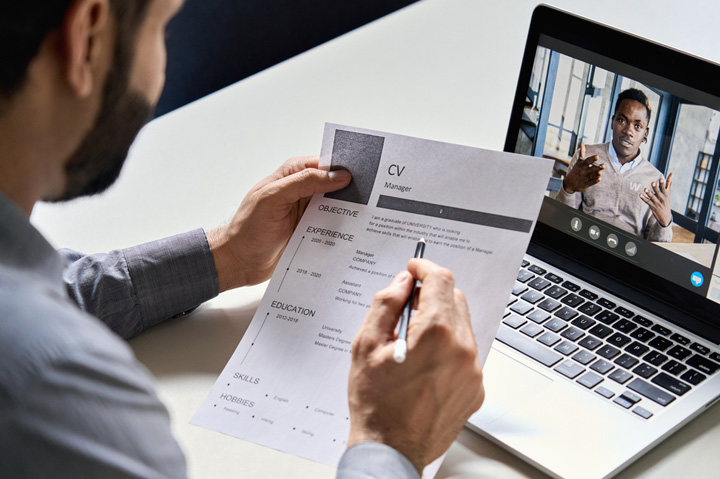September 16, 2022
6 Best Practices to Nail a Virtual Job Interview
Conversations over a video platform are quickly becoming the norm at companies of all sizes. Here’s how to make the best impression virtually.
These days, there’s a good chance that your first few interviews for a new job may be conducted virtually, even if the position isn’t totally remote. According to career-search website Indeed, 93% of employers plan to continue using virtual interviews in the years to come, citing a quicker hiring process, more relaxed candidates and less health risk. Interviewees also don’t have to worry about traffic jams and navigating a labyrinthine office.

But while calls over Zoom, Teams or Google Meet can be more convenient for everyone, they can also present possible pitfalls that interviewees should be aware of. As the old adage goes, there’s no second chance to make a good first impression. Here are six essential tips for hitting it out of the park.
1. Minimize distractions.
It’s critical that the call be as distraction-free as possible. Ask family members for space for a while, close the door if possible and let Fluffy and Fido know you’ll be back soon. While past team members may have welcomed your cat sitting on your lap during meetings, a job interview needs to be serious and distraction-free. Also, join the call a few minutes early – it’s OK to sit in the virtual waiting room for a bit. Don’t take a chance on keeping your interviewer waiting for you to appear, and definitely don’t join after the meeting has started.
2. Be aware of your background.
Find a comfortable spot that’s also professional – perhaps a plain wall with a single shelf or neutral artwork behind you. Avoid anything in the least bit controversial and don’t use virtual backgrounds like the beach or mountains. An office-like setting is best. Also test your lighting and use an extra lamp if necessary to illuminate your face so interviewers can see you well. Remember, lighting changes all through the day, so make sure to test it at your exact appointment time in the days beforehand and make adjustments as necessary.
3. Get fully dressed.
It’s tempting to just worry about your top and wear shorts or sweatpants on the bottom. But if you hop up for a second to close the door and forget you’re wearing printed PJ pants, it won’t make a good impression on your interviewer. Pick out your outfit the night before – opt for a well-fitting top in a neutral color – and iron or steam as necessary beforehand. And consider using a quality headset with a mic so they can hear you clearly; built-in mics in laptops can sound faint.
93%
the percentage of employers who plan to continue using virtual interviews in the years to come.
(Indeed)
4. Test your connection.
It’s critical that there aren’t any interruptions to your audio or video during the interview. Sit in a location where you have strong Wi-Fi, or even better, use an Ethernet cord for a hard-wire connection. Stuttery streaming and dropped calls will interrupt the flow of the conversation – and may make the interviewer question how prepared you are and how reliable your connection will be during remote work.
5. Keep notes handy.
Know your resume well, and take some notes beforehand on typical interview questions that you may be asked, as well as your job experience. It’s OK to reference them occasionally, but you don’t want to sound too scripted. And as with all interviews – in person or virtual – do your research beforehand on the company and the people you’ll be speaking with (like their title, role and direct reports) and think of questions to ask of them so they know you’re engaged with and interested in their mission and the job you’re applying for.
6. Practice with a friend.
Ask a friend or significant other to host a mock interview with you. Test your connection, lighting and background, and have them ask you common hiring questions so you can practice your answers. This is also a chance to educate yourself on the video platform you’ll be using for the interview. Be sure that you’re comfortable logging on, muting and unmuting and granting access to your camera, so your experience is as smooth as possible on interview day.
